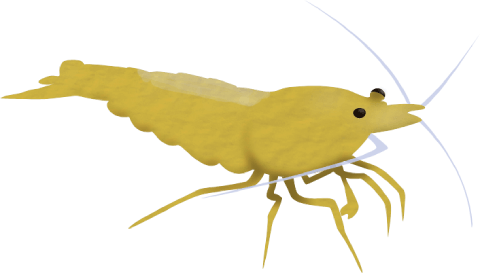- Common names
- Yellow Sakura
Water parameters
- pH
- 6.5 - 8.0
- GH
- 4 - 10
- KH
- 1 - 8
- TDS
- 100 - 250
- Temperature
-
15 - 30 °C
59 - 86 °F
Facts
Difficulty level- Easy
Lifespan- 1 - 2 years
Origin- Taiwan
Adult size- 30 mm / 1.2 inches
Yellow Fire shrimp are a bright sunshine-yellow morph of Cherry shrimp from Taiwan. Their strong colouring makes them stand out in a planted tank, adding a welcome splash of colour.
Being part of the Neocaridina family, Yellow Fire are hard water shrimp so prefer being in water with a relatively high GH value. A similar looking shrimp exists called the Yellow King Kong but it’s part of the Caridina species and prefers softer water.
A fully grown adult will get to around 3 cm (1.2 inches) in size.
Grades
High grade Yellow Fires will be a vibrant yellow colour, almost neon like a high vis jacket. The shell must be consistent in colour too with no patches of translucent shell, light or dark patches, etc.
A lower grade would likely be softer in colour, more like a banana than a neon yellow. Their shells will probably have areas missing colour, similar to a Rili shrimp, and have light and dark spots.
Care
It’s quite easy caring for Yellow Fire shrimp, just like with other Neocaridina types. With plenty of food and the correct water parameters, they can be expected to live for up to 1-2 years.
They’re one of the hardiest shrimp, flourishing in a wide range of water conditions. They should fit in well with most home aquariums, with a KH range of 1-8 and a GH range of 4-10 to avoid any molting issues.
A heater isn’t necessary to keep Yellow Fire shrimp, as long as your room stays above 15 °C (59-86 °F). Unless you get very cold weather in the winter, or have your shrimp tank close to a window, in which case you probably should get an aquarium heater to be safe.
A minimum tank size of 5 gallons (19 litres) is recommended for freshwater dwarf shrimp, but 10 gallons (38 litres) and greater is preferable.
Diet
Generally, all freshwater dwarf shrimp will eat the same types of foods. They’ll spend most of their time scouring the aquarium for biofilm and algae, which will grow on basically all surfaces. If your tank is established and filled with plants, they should have enough natural food to eat.
If you’re not sure if there’s enough biofilm in the tank, feed your shrimp typical meals like algae wafers, bee pollen, shrimp pellets, and blanched veggies.
Your Yellow Fire shrimp will receive all of the nutrients they need to develop fully and safely molt if you feed them a balanced diet of different foods.
Tank mates
Introducing multiple Neocaridina species colour morphs might result in “wild type” offspring, a morph that is nearly transparent but with brown spots/stripes. You should aim to keep only one colour together at a time to produce strong and consistently coloured shrimp babies.
Find the ideal water parameters and compatible tank mates for Yellow Fire shrimp.
Yellow Fire shrimp and Amano Shrimp are a popular combination. The Amano may grow to be a little bigger, and their colours and patterns set them apart from the other Neocaridina. There’s also no possibility of interbreeding because they’re a separate species that need brackish water to raise their young.
It’s sometimes possible to keep smaller fish like Neon Tetras in a shrimp tank. There is a risk that the fish will see your Yellow Fire shrimp as food though, so you should make sure they’ve got plenty of hiding places if you wanted to try this. The risk of being eaten is much higher for baby shrimp, so if you’re planning to breed your shrimp it’s highly recommended not to have any fish in the same tank.
Almost any snail, such as Ramshorn or Nerite snails, may live in the same tank as a group of Yellow Fire shrimp. Snails also share the shrimp’s desire for harder water as they can readily obtain all of the minerals they require to produce a strong, healthy shell.
Breeding
Unlike Caridina shrimp, when different colour Neocaridinas breed together the result is normally a lower-grade copy of one of the parents. The babies could go straight to a very low-grade yellow, or a “wild type” which is mostly translucent with brown spots and stripes.
By consistently culling (i.e. moving to a separate tank) the lower grade yellows, you can gradually improve the grade of your Yellow Fires. You’ll need to be patient when trying to improve your grading as there are no guarantees with nature and you could have a mix of grades for quite a while.
However, there are a few shrimp breeding tips you can read to try and improve your chances and hopefully speed this process up.


